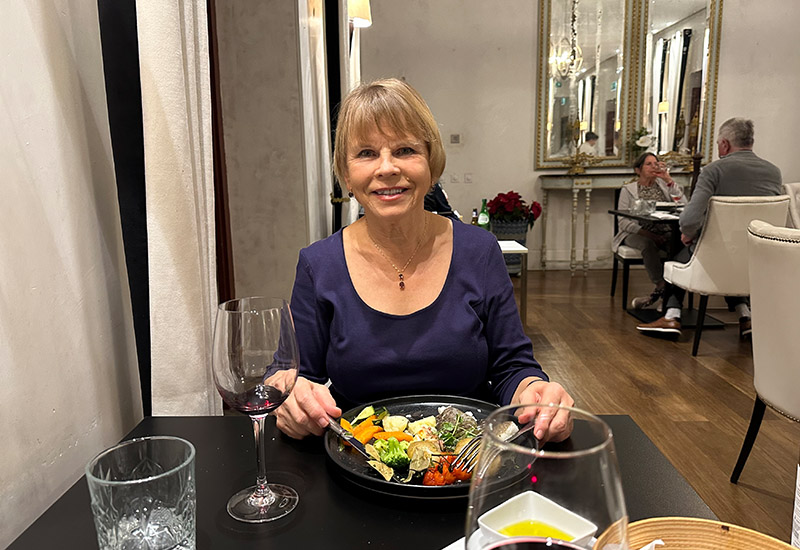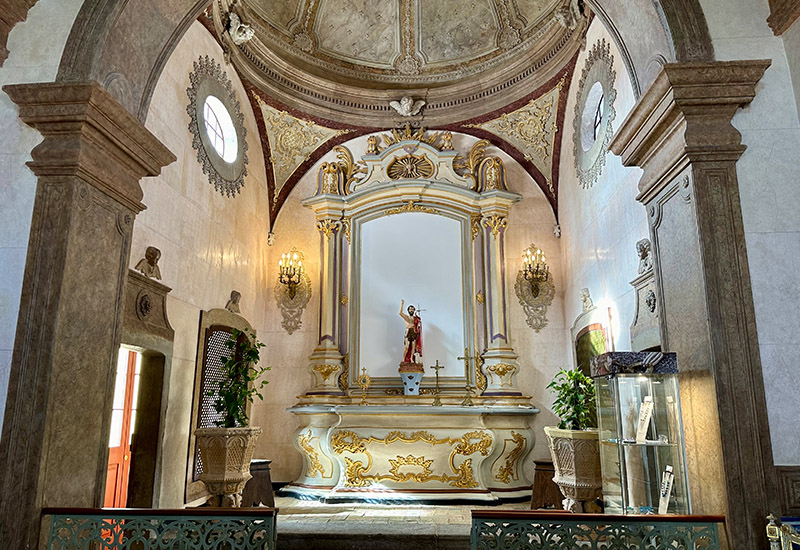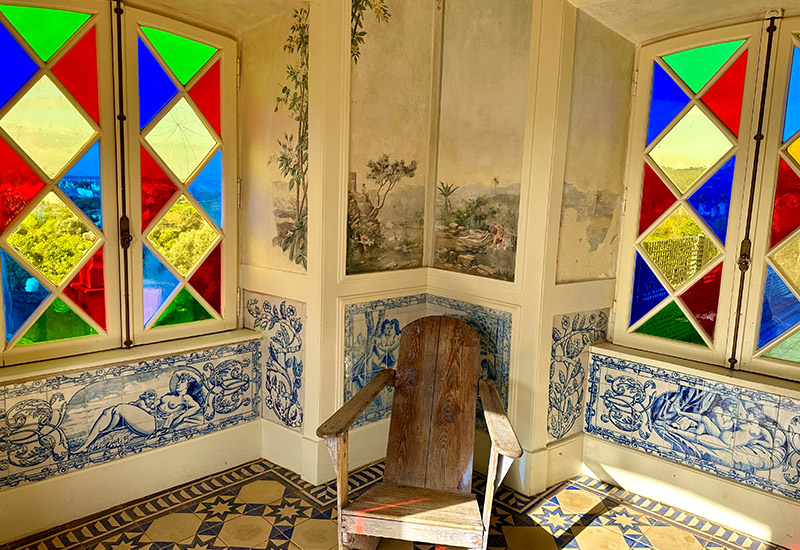I wanted to make this year’s birthday celebration special. Overcoming the idea that the Pousada chain of luxury hotels was reserved for the wealthy and famous, I decided to stay at one this year. The clear choice was Estoi Palace Hotel, only 10 km from Faro. We were in for a remarkable experience.

After manoeuvring through the narrow streets of the village of Estoi, we eventually arrived at the main entrance. There was plenty of car parking space, including an underground car park, handy during the busy season.
We knew we had reached our destination once we saw the plaque reading Pousada and Small Luxury Hotels of the World. A striking bell tower flanked the door; the moment we stepped inside, it became clear why. The chapel we entered also functioned as a reception area. First impressions always matter. Seated behind a wooden desk, Sara, the receptionist, warmly greeted us. As she did the check-in, she kindly provided us with a glass of bubbly, which was a pleasant surprise.

I revisited the reception/chapel later to take a more detailed look. The impressive Louis XV style reflected the dedication to the Sagrada Família. The exhibition space formed part of the museum collection and featured the history of the region and its Roman, Islamic, and classical influences.
After a quick tour of the salons nearby and summarising the palace’s history, Sara took us to the modern annexe where the bedrooms are situated. All 63 of them. What a contrast to the sumptuous interior of the palace building. Nevertheless, I enjoyed the minimalist ambience, featuring lengthy carpeted hallways and strategically placed leather armchairs for contemplating the modern artwork displayed on the walls. Our spacious bedroom had a pared-back style with white walls and dark wood. The floor-to-ceiling windows and the sliding door gave access to the south-facing private terrace with a view over the garden. I knew I would have a comfortable night here.

A compact spa area with a sauna, steam room, and indoor and outdoor swimming pools allows guests to relax before the evening meal.
Exploring the rest of the palace would have to be postponed until morning, as it was time for the celebratory dinner. Viscountrestaurant has an interesting entrance through the former palace kitchen. The old telephone system, original stove, chimney with restored tiles, and washbasins are here.

We were well served by cheerful Elisabete, who ensured no garlic was in the bacalhau dish I ordered and even substituted the olives in garlic with a cheese platter. It’s unfortunate to be intolerant to garlic, especially in Portugal! My partner’s selection of grilled octopus was just as delicious. All washed down with the best Alentejo wine.
After enjoying a hearty breakfast honouring regional delicacies, we were eager to explore the palace the next morning. Full marks again for the food.
With its stunning pink rococo façade and Versailles-inspired gardens, Estoi Palace is an extraordinary illustration of romantic architecture in Portugal. But how did it come about? Upon further investigation, I discovered the palace has a fascinating but tumultuous past. Originally, Marshal Francisco de Pereira Coutinho, who had connections to the high nobility and royalty, built it as an 18th-century farm. But this farmhouse was far from ordinary. The National Palace of Queluz, situated close to Lisbon, was a source of inspiration. The building was described as: “a farm with splendid houses, corresponding gardens and farmlands regulating everything for magnificence and recreation with beautiful streets uniting the buildings and walkways, entrances and porticoes supported by robust pillars.” As an aftermath of the earthquake of 1755, the region had a climate of profound economic and social change. Bourgeois households with more liberal ideologies gained power in urban centres, and old noble families were retreating to their properties in the interior and the Algarve. Hence, the creation of the sumptuous ‘farm’ in Estoi.



Construction of the current palace started in the 1840s, with Coutinho’s son, Fernando de Carvalhal, drawing inspiration from the Pena Palace in Sintra. After his death, the palace changed hands among family members and was left abandoned until 1890. Francisco da Silva, a wealthy pharmacist and landowner of Estoi, came to the rescue. Enlisting the expertise of notable architects and artists, Francisco da Silva finalised the undertaking in April 1909. The cost of the project exceeded nine thousand réis, a substantial amount for that time. In appreciation for his work safeguarding a prominent Algarve monument, King Carlos I bestowed upon José Francisco da Silva the title of Viscount of Estoi. The palace and its gardens were officially opened from 1–3 May, 1909, with a spectacular celebration coordinated with the help of Faro’s civil and religious authorities. The Algarve had passed a landmark.
However, the palace’s troubles didn’t stop there. After da Silva died in 1926, the property suffered neglect and changed ownership numerous times. Nevertheless, authorities recognised its importance and officially categorised it as a Public Interest Building in 1977. Nothing much happened until the Faro municipality came to the rescue in the late 1980s. Extensive restoration work began, and it was later opened as a luxury hotel.


Delighting visitors, the palace has fully recovered and hopefully secured its future. The mix of interior styles includes rococo, neoclassical, and Art Nouveau elements. The three halls, accessible to guests, showcase opulent ceilings, lavish carvings, and amazing frescoes. With fresh golden stucco and original gilt furniture, the Great Hall, formerly the old hall of palace receptions, is a sight that will make you stop in your tracks.
The palace was constructed on hilly terrain, whereas the garden was established in flat areas more suitable for farming. The design of this space includes three interconnected levels with a double staircase on each side, embellished with colourful blue azulejo tiles and hidden grottos underneath. The dominant style of the garden is baroque, with busts and statues, including an 18th-century nativity scene.

The third level is located next to the palace building, accessed by stairs and considered the formal garden. It has two viewpoints. Here, you can take in the sweeping vistas while enjoying a relaxing drink in the tea rooms.
Since 2009, Estoi Palace has been operating as a pousada. But what exactly is a pousada? Dating back to the 1940s, the concept of rustic, truly Portuguese state-run hotels was first envisioned by the head of the National Propaganda Secretariat. Later, it expanded to encompass a variety of heritage edifices, such as castles, convents, and monasteries. Many historical buildings that were left abandoned have been restored for this specific reason. After privatisation in 2003, the management of the hotels in the Pousada chain was entrusted to the Pestana Group.



My stay at the Estoi Palace Pousada was enjoyable and will be one of my most memorable birthdays. Now, I must decide what else needs celebrating and choose the next pousada. There are over 35 enticing contenders in the rest of the country. Which one should it be …?













